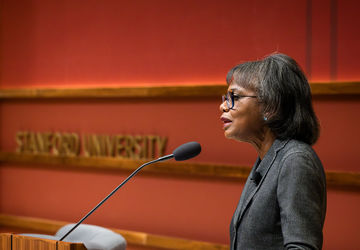Paula Giddings as an agent for change

Many have spoken on the necessity of alliances across social divisions, but renowned historian, Paula Giddings, provides new insights on how history reveals key inspiration and lessons. Misremembered history, Giddings argues, has limited our view. However, restoring the full history — and particularly black women’s early leadership and involvement at the nexus of movements for both gender and racial equality — offers provocative new possibilities.
On October 9th, Giddings spoke about “women, race and movements for change” as the 2014 Jing Lyman Series lecturer. Funded by the Clayman Institute for Gender Research and an interdisciplinary cohort of programs and departments, the Jing Lyman lecture dovetailed with a conference about online feminism where Giddings and other panelists explored alliances across race and gender in the context of online social movements today, drawing parallels between past and present.
In her lectures, Giddings drew clear links between the predominant myth of the beginnings of the women’s movement at Seneca Falls and the typecasting of women and feminists as white — separate from those involved in racial liberation movements. Ignorance of claims about more diverse origins of the movement have made us resist the history of race/gender alliances and the idea of intersection that coheres them.
Many of these alliance-builders have been black women, who are marginalized when race and gender are seen as discreet social categories. Instead, Giddings argued, there are substantial and long-standing discourses—not to mention common sense—that tells us that “everyone is raced, everyone is gendered and that these social identities do not stand alone.”
Central to Giddings’ talk was the idea of narrative history and myth – not as fiction, but as a story “used to give meaning to the world.” For feminism, the principal myth originated with a history written by suffragists Elizabeth Cady Stanton and Susan B. Anthony, who were themselves complicated figures of alliance and division. The framework they built reified divisions through their racist and separatist rhetoric that had flared over the Fifteenth Amendment that granted black men suffrage but not women.
Nevertheless, debates did not divide neatly between men and women, or whites and blacks. However, the history published by Stanton and Anthony pitted progress for (white) women against racial progress. This approach undermined both whites and blacks, the latter including poet and author Frances Ellen Harper, who believed that black rights and women’s rights were “all bound up together.”
A particularly clear example of how that story informs the present was evident in the narrative history that was produced by the MAKERS series for PBS. When Giddings served as a consultant for the multimedia project about influential women, she received a list of names that were categorized as either feminists (all of whom were white) or civil rights activists (all black). “It was then that I understood why so many of the feminist intellectuals and activists of color I recommended had no place in their version of women’s history,” Giddings noted.
In her own words, Giddings is “no Pollyanna,” assuming cheery friendships across painful divides. The legacy of racial exclusion based on a faulty framework of women’s rights activism continues to forestall vital alliances and limits its achievements and goals.
What if,” Giddings posed to the enthusiastic applause, alongside feminism’s focus on making women’s status as equal to men, “what if one of our principles was making women equal to women?”
To get there, Giddings asserted, we need to integrate both the harsh lessons along with hope from the past. A century ago, Ida B. Wells-Barnett created bi-racial alliances to fight lynching, mass incarceration, and economic injustice suffered by black men and women. She was also an ardent suffragist who mobilized both black and white women to fight for the passage of the 19th amendment giving women the vote. An adamant believer in alliances, Wells-Barnett continued to strive for them despite the difficulties and frustrations that are still all too familiar. But Wells-Barnett continued with the belief that women, together, could “accomplish the reforms that the pulpit and the law have failed to do. Organized women…were best fitted to move the society forward...” she said, but warned that “white women themselves had to be emancipated from the prejudice which fetters their noblest endeavor and renders inconsistent their most sacred professions.”
"Alliances are both essential and difficult," Giddings explains, "But you embrace those things, you embrace being an agent for change, which is a thrilling way to live your life.”


